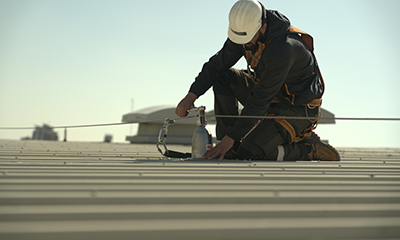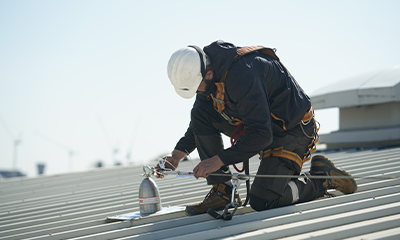Fall Protection
The award winning fall protection systems developed by SFS protect people who work at heights
A designer or building owner must ensure the safety of a worker, if the need to work at height cannot be avoided, as detailed under Regulation 9 of CDM2015.
‘Avoid work at height wherever possible!’
This is a well-known Health and Safety protocol, where working at height is required, we are all responsible for minimising the risks. When roof access cannot be avoided, a collective method of fall protection should firstly be considered, all current guidance calls for ‘work restraint’ systems as the best option. SFS design to restraint by default. A system can only be deemed restraint where there is no possibility of a fall.
The safest method should be prioritised without the prejudice of a cost saving. Arrest systems should only be considered as a last resort.
Fall Restraint
- No risk of a fall
- A typical restraint system is set 2.3m back from the roof edge or potential fall hazard. The user’s path is dictated.
- No need for a rescue plan, minimal PPE and user training required.
- A system can only be deemed restraint where there is no possibility of a fall.
Fall Arrest
- Potential for a fall
- Requires specialist PPE, user training and a rescue plan to be in place.

 English (Canada)
English (Canada)
 čeština (Česká republika)
čeština (Česká republika)
 magyar (Magyarország)
magyar (Magyarország)
 Deutsch (Deutschland)
Deutsch (Deutschland)
 eesti (Eesti)
eesti (Eesti)
 español (España)
español (España)
 português (Portugal)
português (Portugal)
 English
English
 suomi (Suomi)
suomi (Suomi)
 français (France)
français (France)
 italiano (Italia)
italiano (Italia)
 Nederlands (Nederland)
Nederlands (Nederland)
 norsk, bokmål (Norge)
norsk, bokmål (Norge)
 polski (Polska)
polski (Polska)
 svenska (Sverige)
svenska (Sverige)
 Türkçe (Türkiye)
Türkçe (Türkiye)




